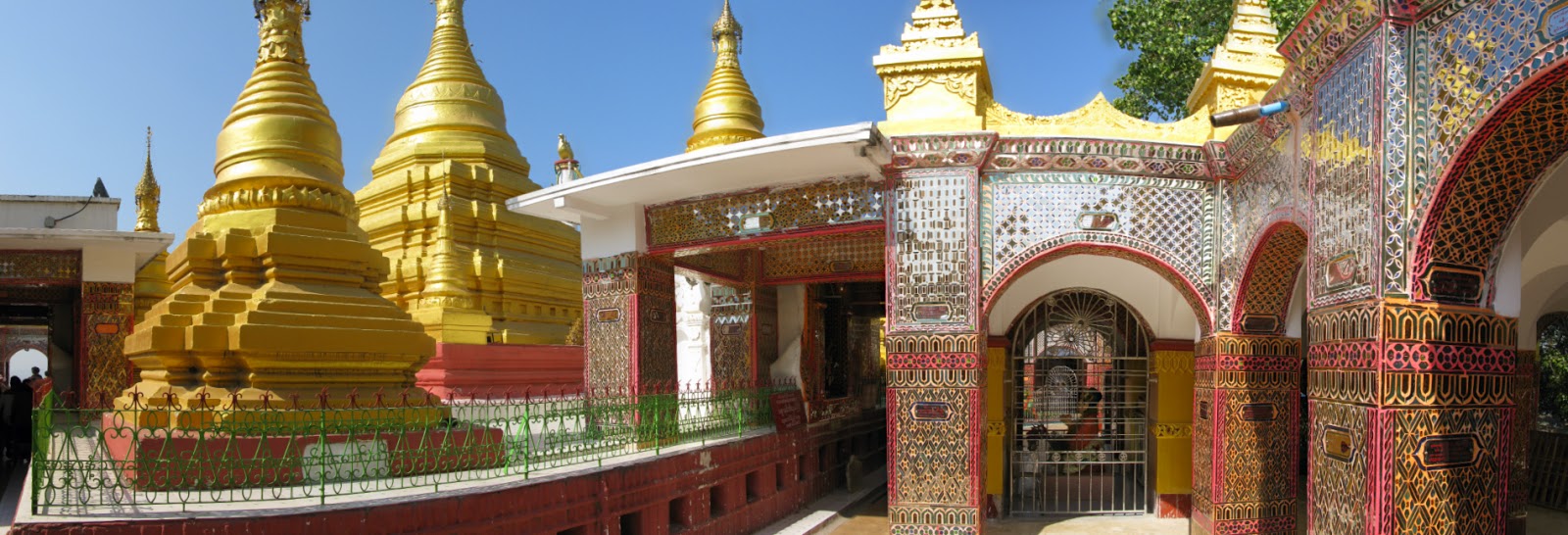 |
| Temple on Mandalay Hill |
We needn’t have fretted about the state of our banknotes – the guy in front of us at Mandalay airport’s currency exchange desk pulled a rolled up wad of sterling out of his pocket, and it was changed without quibble. Apparently Myanmar recently instructed its banks to be less picky about the state of tourists’ money – presumably it’s dawned on them that it doesn’t actually affect the value, and what matters is how much they change. The black market still probably values pristine notes though, as these are what Myanmar citizens like to tuck away between the pages of a book as a precaution against the military government arbitrarily declaring certain denominations of Myanmar currency worthless. At one time notes were reissued based on multiples of 9 instead of 10, because the head honcho considered 9 a lucky number. We changed US$500 and became instant kyat half-millionaires.
The road to Mandalay from the airport, a wide new dual carriageway with bougainvillea marking the central reservation, was almost deserted even though it was the middle of the day. Not a great road though – the bus bucked and reared over the dips in the surface as though we were on some giant carnival ride. Golden pagodas peeped out from the tops of the low trees – I don’t think there were fewer than six visible at any one time, and they crowded thickly on a distant hilltop.
 |
||
| Fish seller, Mandalay. Not flying fish though. |
The streets of Mandalay city are laid out as a numbered grid which makes navigation easy. I managed to note the position of 31st Street as we headed north on 80th, so by the time the Air Asia shuttle bus pulled up near 26th I knew our hotel was just further than we really wanted to walk with luggage, but certainly not worth the 4000 kyat demanded by the circling taxi drivers. One of them settled for 2000.
We had a whole week in Mandalay, so weren’t in a rush to do anything. The afternoon than we arrived we scoped out the area around the Hotel Victory Point for places to eat – two or three dingy looking local restaurants with food being kept warm in pots (no thanks), a couple of bright, clean Chinese places, and two upmarket bistros with European and Burmese dishes at above-budget prices. So Chinese it was – which is what ordinary Burmese folk like to eat when they dine out.
We had planned to leave Mandalay by boat to Bagan, for which we needed to acquire a ticket. The hotel would supply one for $40 each, but I had read that they actually only cost $35, so we spent Friday in a fruitless hunt firstly for the office of the boat company, which was supposed to be somewhere in the railway station (no sign), and the alternative, a travel agent who sold boat tickets (no sign of one of those either). We did however get to look at two shopping malls, one full of indifferent clothes shops but with a supermarket in the basement, and one full of upmarket designer shops and no customers. As we picked our way across the railway line we also got a close look at Burmese train. It did not look inviting, and caused us to wonder if we might be able to return from Bagan by taxi, rather than enduring 7+ hours on the reputedly bone-jangling railway tracks.
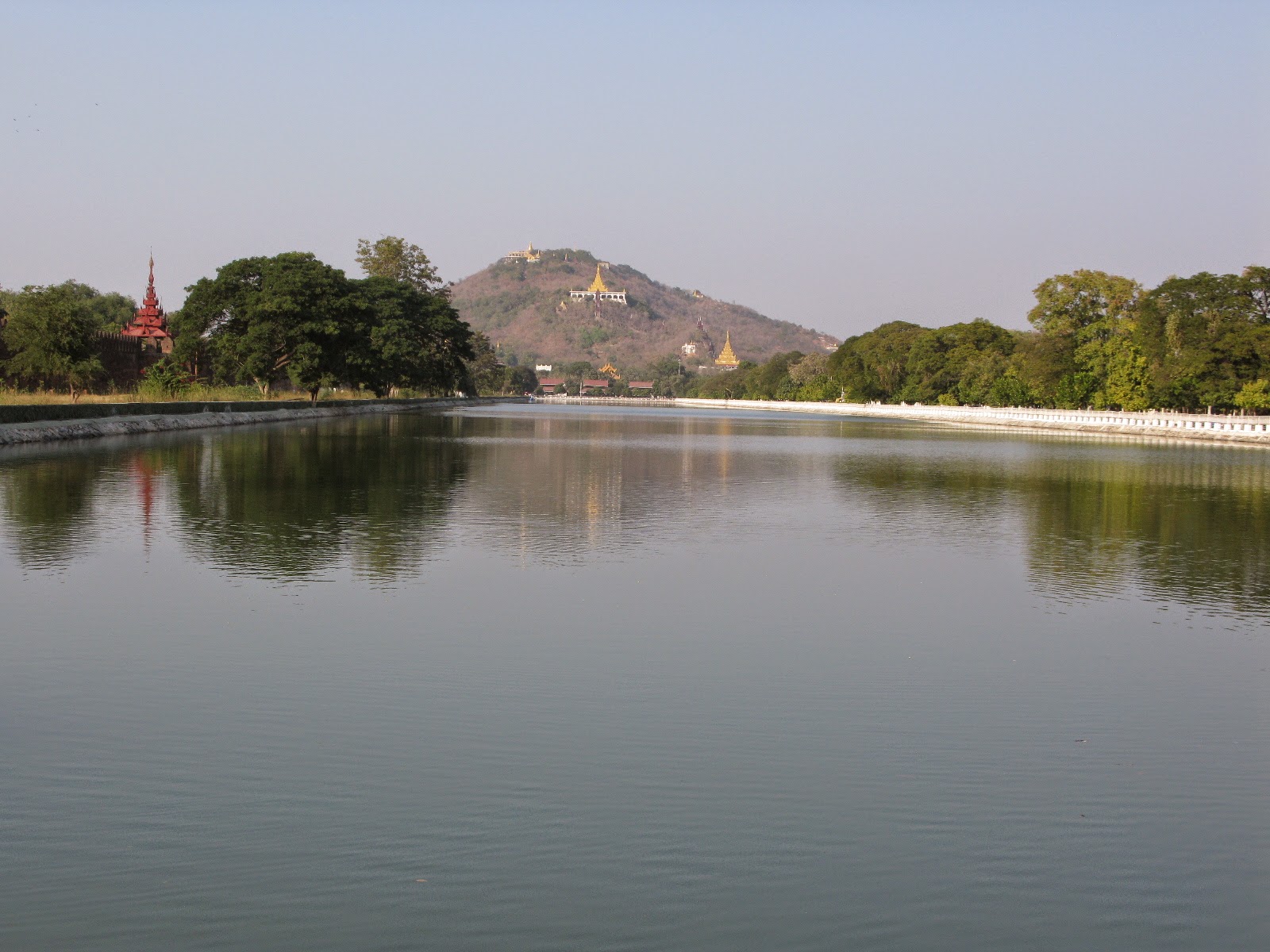 |
| The moat around Mandalay Palace, with Mandalay Hill beyond. This shows half of one side of the palace perimeter |
A google search that evening produced the details of a travel agent that appeared to do taxi bookings, so the following morning saw us heading for the south east corner of the vast royal palace enclosure that dominates Mandalay’s geography. Each side is over 2 km long, demarcated by a 200ft wide moat and crenellated red brick walls backed by trees. Most of the site is occupied by the military so you can’t even cut across it on foot – we trudged the full length of the southern wall, and rather wished we’d taken a taxi.
According to the helpful lady at Zone Express, a taxi from Bagan to Mandalay would cost abut $150 – rather different from the $80 suggested by their website! However there was a minibus service – a 3.5 hour journey for $12 each, pick up and drop off at our hotel, and we could specifically book the front seats with the extra leg room. Sold. Sold, in fact, in both directions, as our plans for the 10-12 hours boat ride were swiftly abandoned. We still wanted to do a river trip though, so we were expertly sold a private all day excursion to Mingun and Inwa for $100. It was the most extravagant thing we had done on this trip, but hey, once a year can’t hurt.
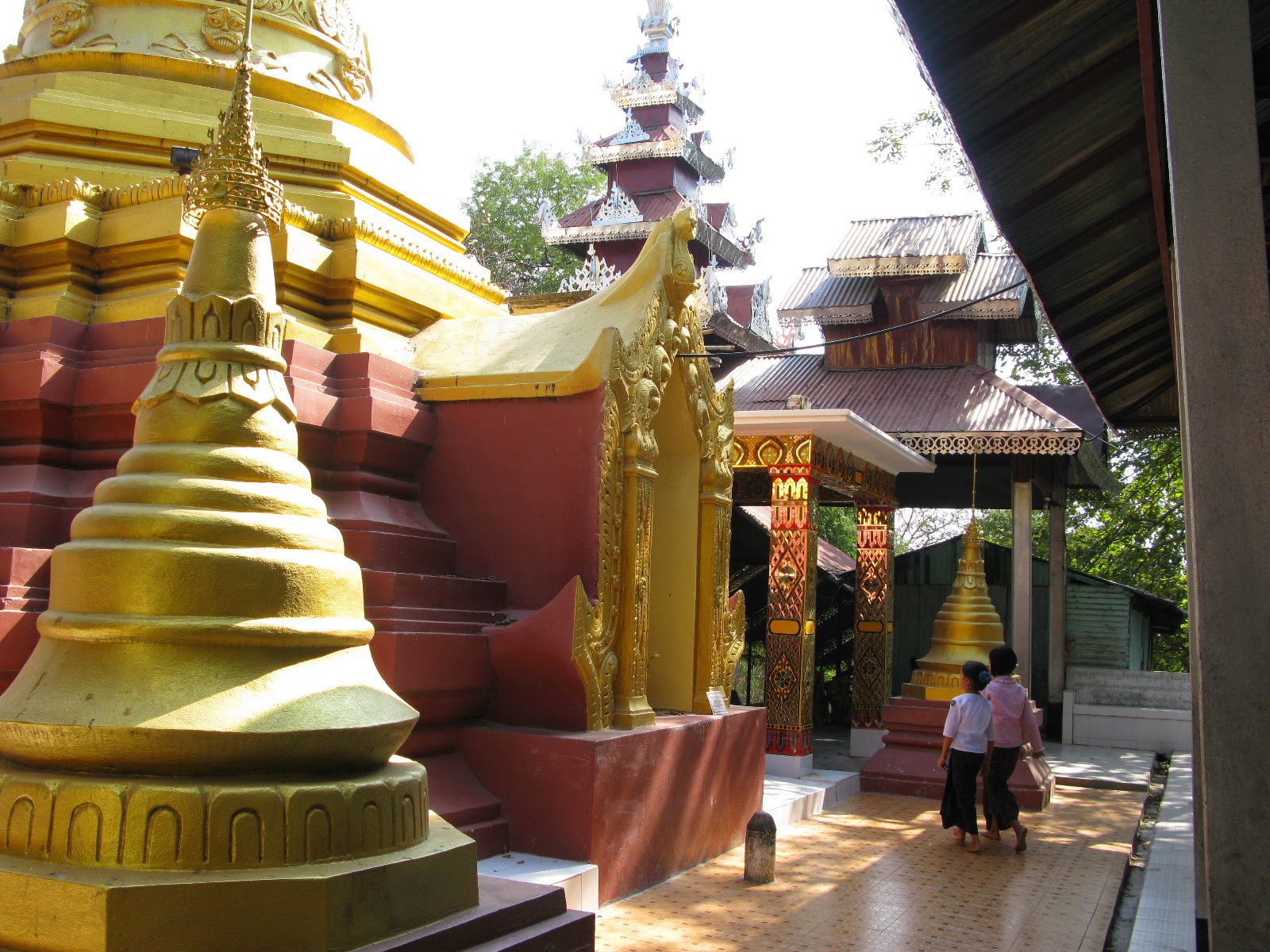 |
| On Mandalay Hill |
Back on 67th Street we came across a taxi whose driver agreed to take us on a 4 hour trip around the sights of Mandalay – as we set off he waved goodbye to his wife who appeared to be picnicking on the pavement with an assortment of children, which was odd because there were no houses nearby.
First port of call was the top of Mandalay Hill – many people walk up but, with 1729 steps, it’s not an easy climb. Before entering the grounds of the temple that crowns the hill, we had to remove our shoes – it’s the same at any religious site in Myanmar, so feet get filthy and I was glad I’d bought a pumice stone in Bangkok. The early afternoon view from the top of the hill was hazy, but we could get a general impression of the city with the green square of the palace area standing out in sharp contrast to the concrete sprawl all around. In the distance the Irrawaddy picked its silver way across a wide band of khakhi earth, while pagodas crowded around the foot of the hill, along with a golf course and a gigantic hotel that looked like something Stalin might have commissioned.
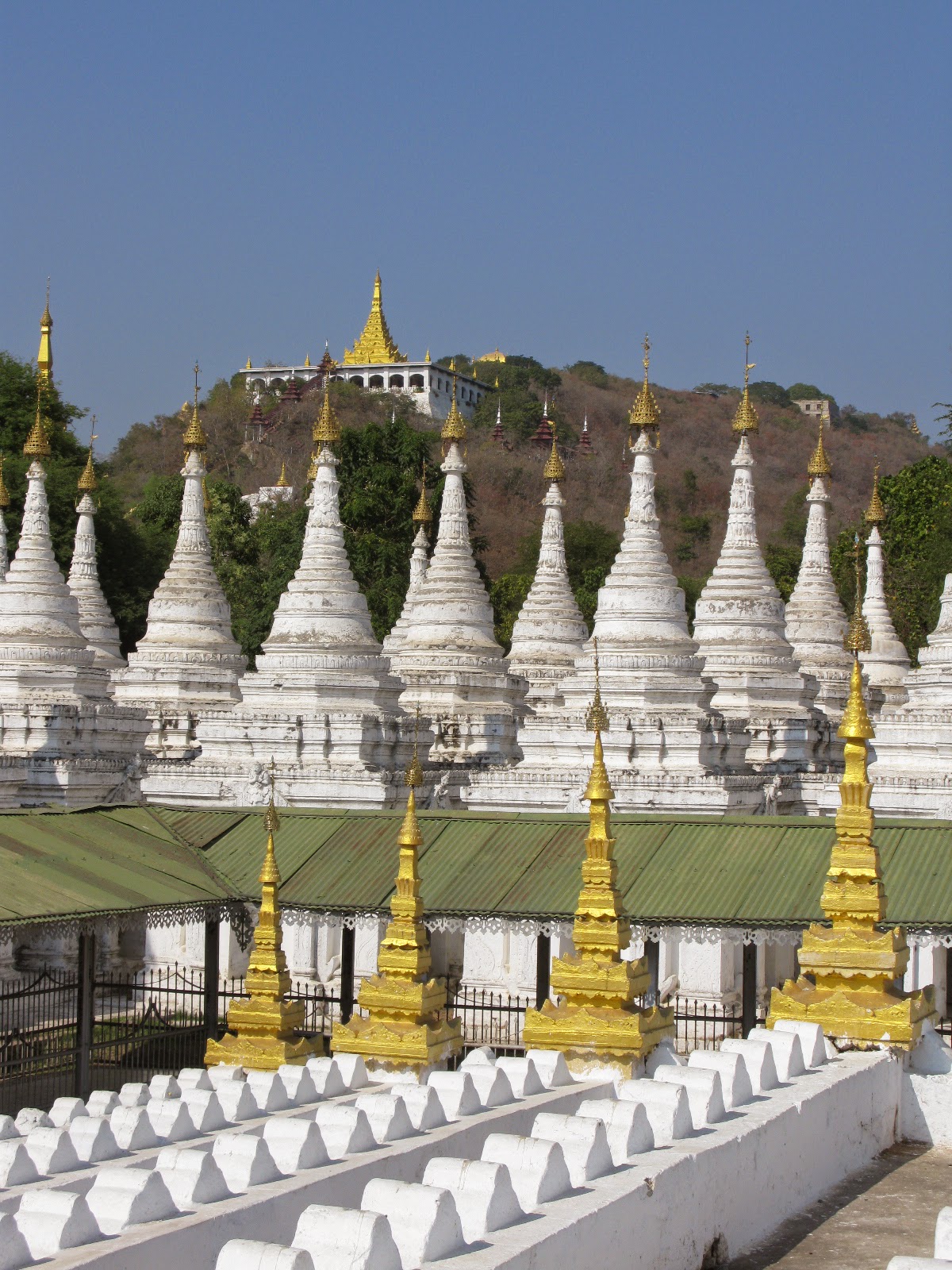 |
| Sandamuni Pagoda, Mandalay |
I had only vaguely indicated the places on the map that we wished to visit, but our driver was well versed in the sightseeing ways of foreign tourists, and whisked us efficiently round an assortment of Mandalay’s more illustrious pagodas and temples before crossing the moat to enter the palace grounds by the east gate, the only one open to tourists. The palace buildings, at the very centre of the compound, are reconstructions of those occupied by the last king of Burma until he was carted off to India by the British in 1885. The originals burned down during WWII. Still, they were worth a visit, and it was easy to see how remote the royal family must have been from their subjects – even with the noise created by present lifestyles, the city of a million people beyond the palace compund walls didn’t register at all.
 |
| Our own boat |
Monday was boat trip day, and we had arranged for the same taxi driver to convey us to the jetty for 9am. A jumble of boats was moored beside the packed mud of the riverbank, and knots of tourists stood around waiting to be claimed by their allotted crew. In due course someone found us and led us down the steep bank and across a plank onto a wooden boat. Then off the other side of the boat across another plank to another boat – in this way we crossed a wobbly raft of five or six boats before reaching one that we concluded must be ours since there was nowhere else to go. We climbed to the upper of the two decks and installed ourselves in the pair of wooden plantation chairs under a canopy, while the pilot and deckhand cast off and a young girl started setting our breakfast table – I almost felt I should be wearing a crinoline and carrying a parasol.
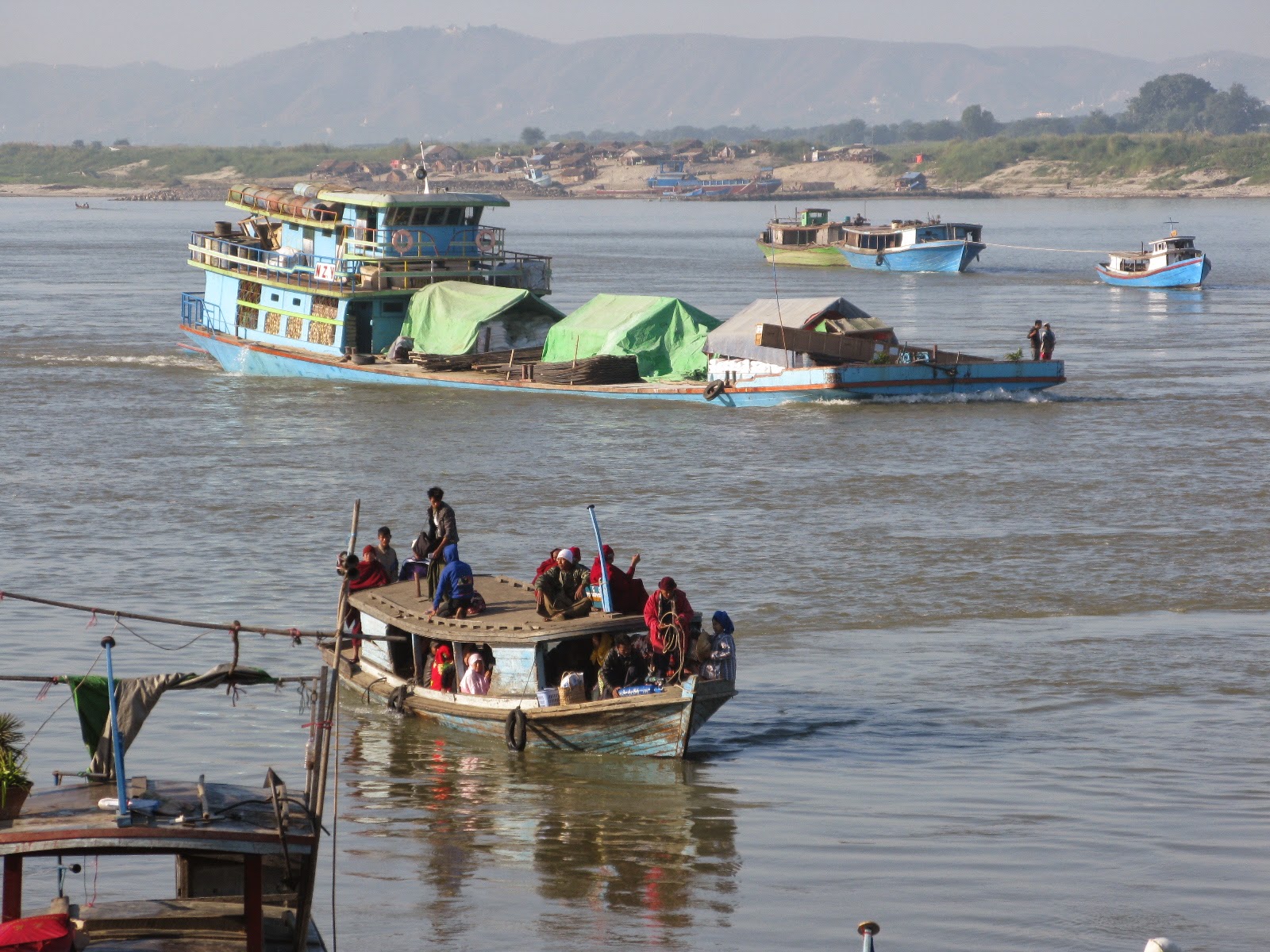 |
| River traffic on the Irrawadd |
The Irrawaddy is wide. That’s a bit of an understatement really – it’s HUGE. Even in Mandalay, almost 500 miles upstream from the sea, it’s well over a kilometre wide – but at this time of year very shallow, so the boat zigzagged across the river to avoid the many sandbanks marked by sticks protruding from the water. I think it may be the busiest river I’ve ever been on, and the couple of dozen tourist boats heading upriver to Mingun were far outnumbered by motorised cargo boats carrying enormous trunks of teak, coal, barrels etc, dredgers keeping the channels open, little longtail boats laden with watermelons, and rafts carrying stacks of fresh cut bamboo poles downriver. I assume that Kipling was referring to the Irrawaddy when he talked about the Road to Mandalay and the flying fishes to be found there – but sadly we saw none. There is no bridge at Mandalay – foot passengers cross in small boats, but vehicles must detour several miles south to Saigaing (until 1998 this was the only bridge across the Irrawaddy in its 1300 mile course. There are still only 16.
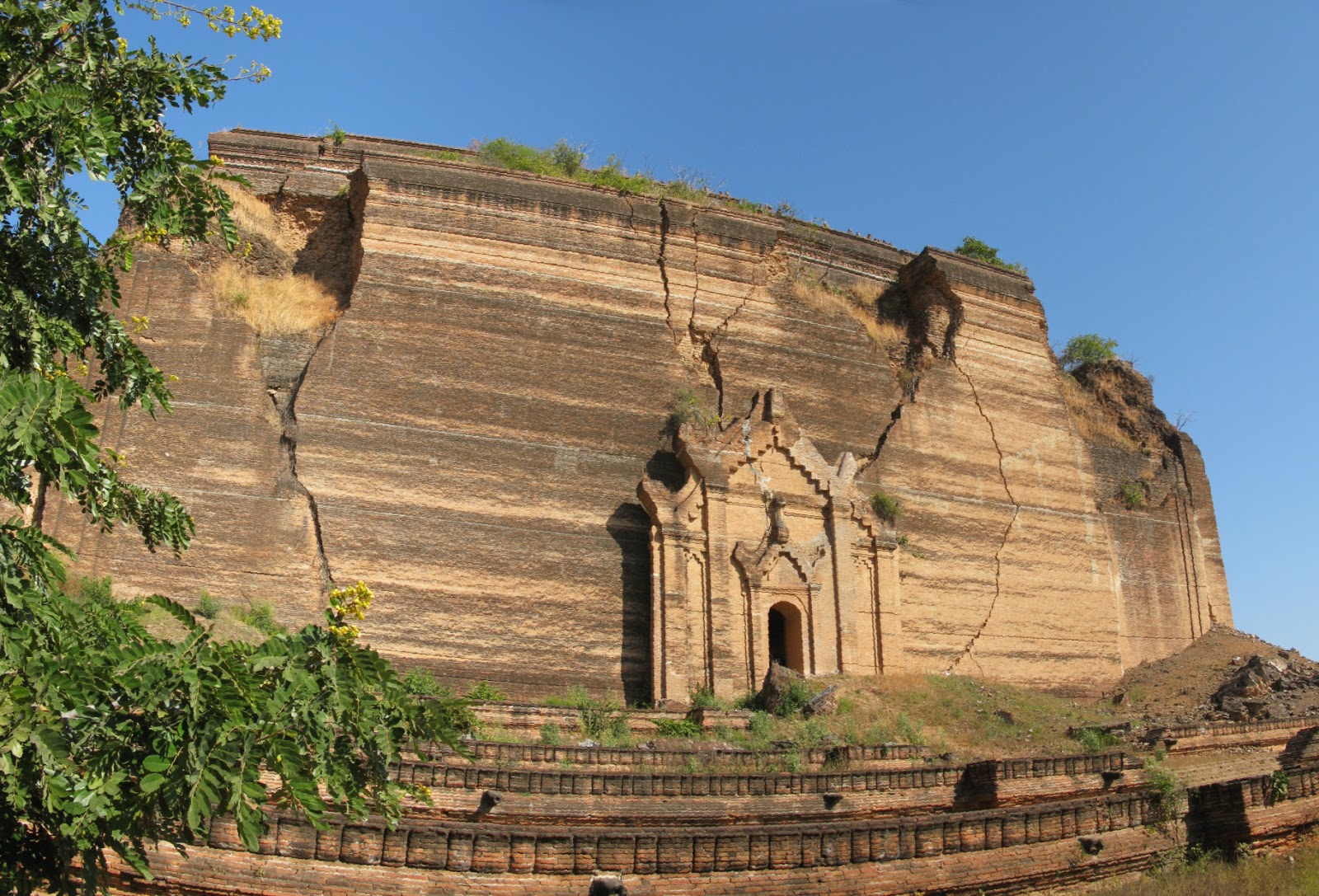 |
| Ruins of unfinished temple at Mingun |
The width of the river and the flat terrain raised several metres above water level meant that little of the passing countryside was visible until the hill and massive ruin at Mingun came into view an hour upstream from Mandalay. If only it had been finished it would have been the largest temple in the late 18th century world, but only the 50m high base was built, and that now stands cracked and crumbling thanks to an earthquake and 200 years of neglect. It’s possible to go inside but it wasn’t on the Mandalay historical sites ticket and we didn’t feel it worth the extra sum demanded. So we contented ourselves with an exterior circambulation before wandering down through the dusty village to view the world’s largest ringing bell and a large, blindingly white stupa that is supposed to represent a mythical sacred mountain. An hour was plenty for the distractions of Mingun, and I was glad we weren’t stuck there for the 3 hours that an excursion by public boat would have meant.
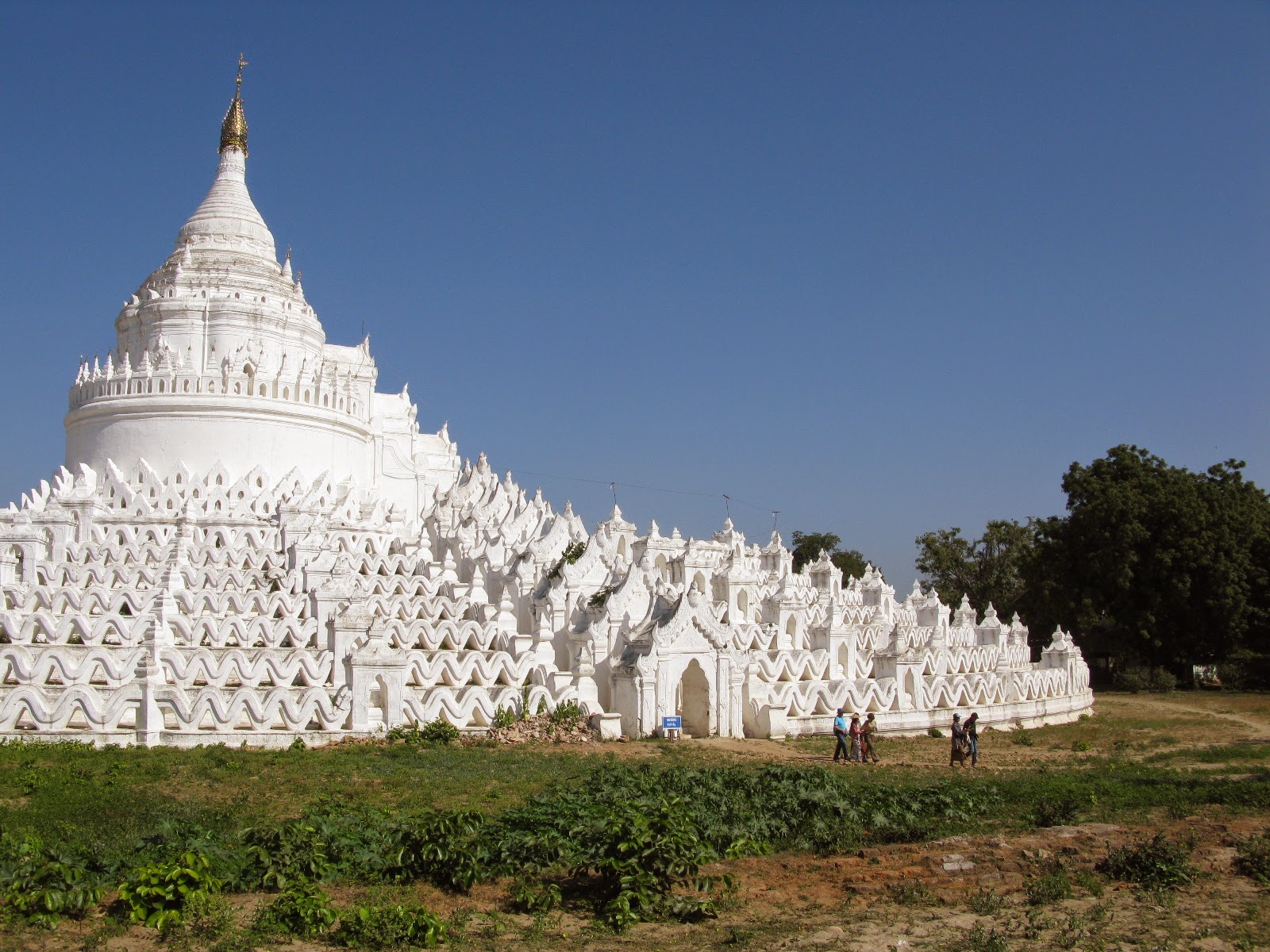 |
| Stupa in Mingun |
Back on the boat, we headed downstream, back past Mandalay and another hour west, past the pagoda-encrusted hills of Saigaing (I gave up counting at 70) and under the old and new bridges before turning up a small tributary and pulling into the bank. After we had finished our lunch (noodles in a coconutty chicken soup – ‘vegetarian’ is not really understood here) we clambered up the bank to pit our best negotiating skills against a horse cart driver. Evidently the base price was now 8000 kyat (the Director of Horse Cart Operations waved a piece of paper at us to prove it), but the scam is to charge unsuspecting tourists that amount for just one hour, when there is no way that the tour can be completed in that time. Even 90 minutes is a rush – the roads and rough tracks at Inwa, a long ruined former capital, don’t lend themselves to haste.
 |
| Horse carts waiting for tourists at Inwa |
There are four stops on the standard tour – a still working monastery (complete with primary school room for mini-monks), a set of ruined temples that to me looked Hindu in architectural style (they reminded me of Prambanan in Yogyakarta, although much smaller), a crumbling watchtower, and a more complete temple complex that was only built in the 19th century. None of the individual monuments would be on anybody’s ‘unmissable’ list but, having been in cities ever since leaving Chapora, it was lovely to be out in the quiet, green countryside, even though trotting along the rutted tracks required a firm grip on whatever bit of the cart was handy. The driver carried a long whip made from plaited bamboo strips but he rarely used it it earnest, instead encouraging his horse forward with low murmurs or simply laying the whip gently across its rump. The harness was well padded and the horse looked in reasonable shape – I just hope it was getting enough water.
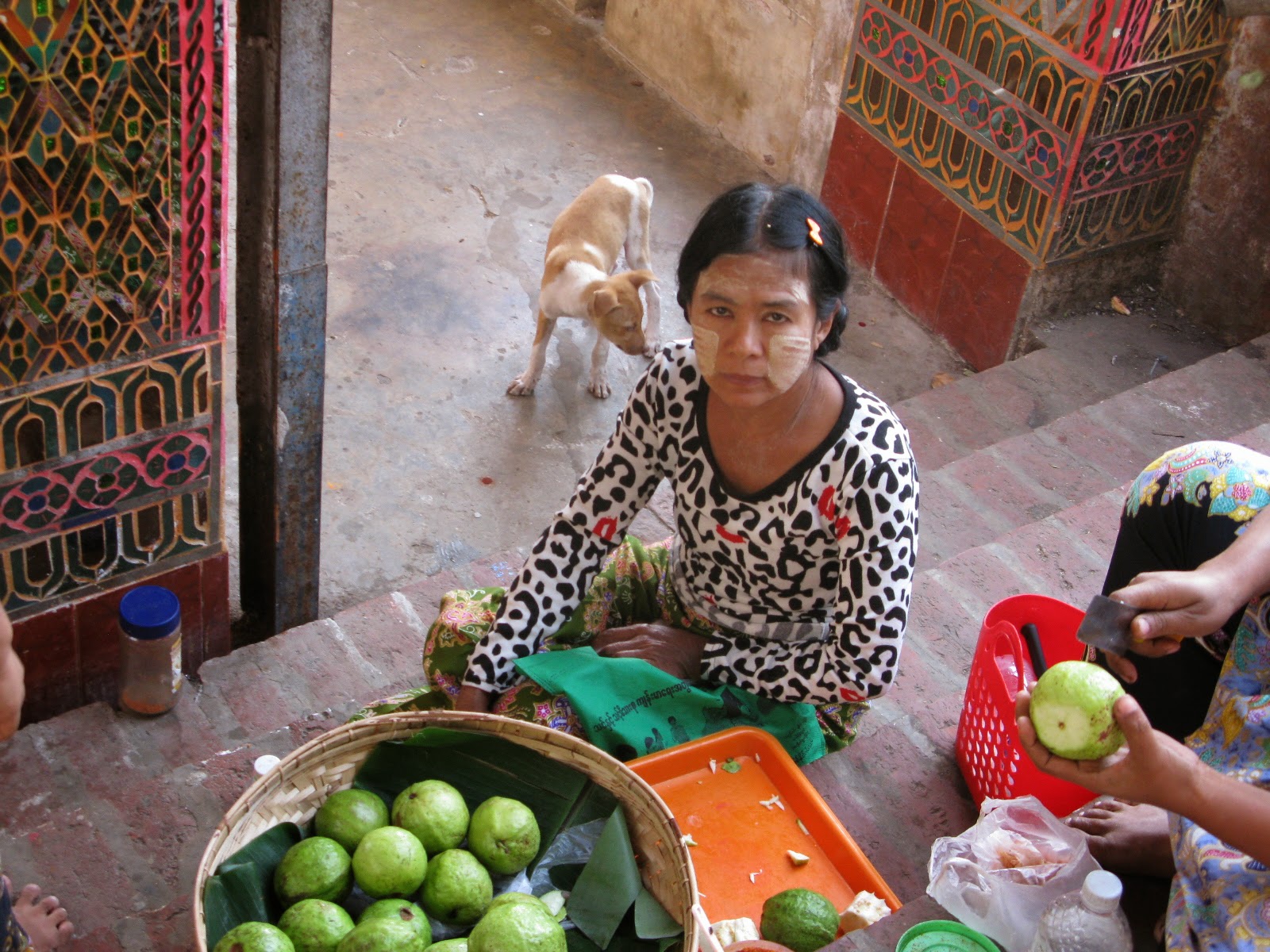 |
| Guava seller, Mandalay. Many women and children, and a few men, wear thetraditional sun protection / skin care preparation made from ground bark. |
We had planned to hit the market the next morning – my handbag, a small woven messenger bag bought in Nepal 12 years ago, was wearing very thin in places, and woven bags seemed to be a speciality of Myanmar. However our plans changed when before breakfast I experienced a couple of light flashes in my left eye and then found I had another floater in it. I had acquired the first floater two days before. Thinking it was a tiny fibre in my eye I had spent ages trying to get it out before concluding that it was internal and, according to the combined wisdom of the internet, not a cause for concern unless several appeared over a short period and/or it was accompanied by light flashes – in which case a retinal tear might be in progress and urgent treatment would be required. Sh*t.
Luckily the hotel’s wifi was working well enough for surfing that morning, and I found the address of American Vision in the centre of town. I just hoped the name presaged an English speaking optician. When we arrived the girl in the shop understood me well enought to relieve me of 15,000 kyat for a consultation, but the young optical assistant to whom I was passed spoke no English at all and proceeded to try to give me a general sight test without having a clue why I was there. Luckily another patient cottoned on (no privacy in a Burmese optician’s consulting rooms!) and summoned an older man who was the actual optician – who miraculously spoke English not just well enough to discuss floaters and retinal tears, but also his admiration for the paintings of Constable and some hitherto unknown (by me) facts about his life. I struck me as a little surreal to be discussing the biographical details of a long dead English Old Master with a Burmese optician in Mandalay, while waiting to learn whether I had a potentially sight-threatening condition. In any case, I much prefer Turner.
 |
| Near the market in Mandalay |
After peering through my drop-expanded pupil, and an ultrasound scan (4000 kyat extra), the optician declared my retina intact (phew) but pointed out the floaters in my vitreous humour and recommended a diet high in protein and vitamin C to try to prevent more. Nothing can be done about the ones I have but they may break up eventually. One is quite small and I don’t notice it much, the other is the exact size and shape of a mosquito permanently hovering one inch in front of my eye – very annoying.
The next moring we had to be packed and ready for our minibus to Bagan to pick us up sometime between 7:15 and 8:15. That’s the downside of a pick-up service – even after our 7:50 depearture from the hotel we drove around fr over an hour collecting other passengers and stopping at the bus station on the southern edge of town to pick up a pack of water bottles. But at 09:00 we were finally on our way out along the airport road before turning down a country lane that didn’t look important eough to be the main road to Bagan. There were no flying fishes there either.
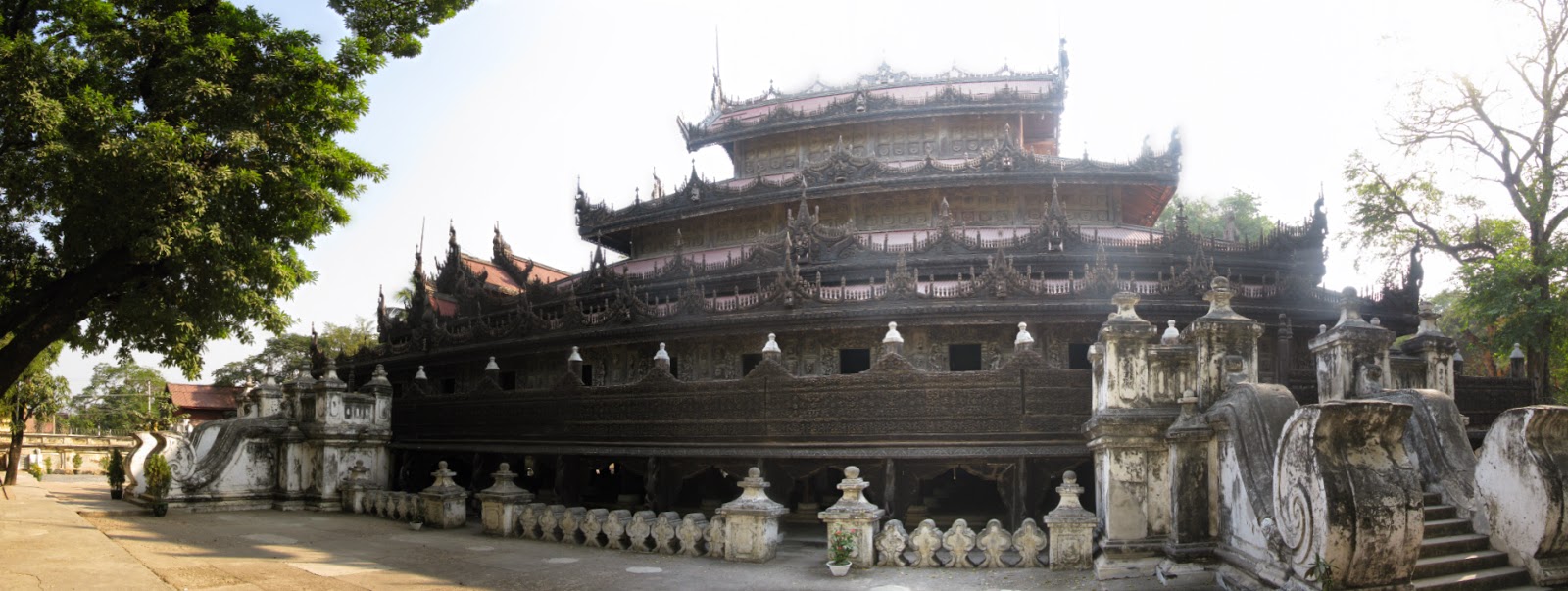 |
| Teak pagoda, Mandalay |

